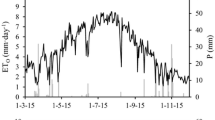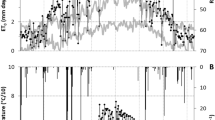Abstract
Increased water scarcity demands more efficient use of water in the agricultural sector which is the primary consumer of water. Precise determination of irrigation requirements based on specific crop parameters is needed for accurate water applications. We conducted a 4-year study on almond evapotranspiration using a large weighing lysimeter. Tree canopies changed from 3 to 48 % ground cover during the course of the study. Sap flow measurements made on the lysimeter tree provided a continuous record of tree transpiration. We propose to use the daily fraction of photosynthetically active radiation intercepted by the canopy (fIRd) as a predictor of almond orchard maximum transpiration. The transpiration coefficient (T/ET o or K T ) was related to the fIRd of the last two years, and the ratio between fIRd and K T stayed more or less constant around a value of 1.2. Such value extrapolated to the size of a mature orchard with 85 % intercepted radiation gives a K T of around 1.0, a number above the standard recommendations, but fully compatible with the maximum K c values of 1.1–1.15 recently reported.










Similar content being viewed by others
References
Allen RG, Pereira LS (2009) Estimating crop coefficients from fraction of ground cover and height. Irrig Sci 28:17–34
Allen RG, Pereira LS, Raes D, Smith M (1998) Crop evapotranspiration: guidelines for computing crop water requirements. Irrigation and drainage. Paper no. 56. FAO, Rome
Auzmendi I, Mata M, del Campo J, Lopez G, Girona J, Marsal J (2011) Intercepted radiation by apple canopy can be used as a basis for irrigation scheduling. Agric Water Manag 98:886–892
Ayars JE, Johnson RS, Phene CJ, Trout TJ, Clark DA, Mead RM (2003) Water use by drip-irrigated late-season peaches. Irrig Sci 22:187–194
Bonachela S, Orgaz F, Villalobos FJ, Fereres E (1999) Measurement and simulation of evaporation from soil in olive orchards. Irrig Sci 18:205–211
Bonachela S, Orgaz F, Villalobos FJ, Fereres E (2001) Soil evaporation from drip-irrigated olive orchards. Irrig Sci 20:65–71
Campbell G, Norman J (1989) The description and measurement of plant canopy structure. In: Russel G, Marshall B, Jarvis PJ (eds) Plant canopies: their growth, form and function. Cambridge University Press, Cambridge, pp 1–19
Casadesus J, Mata M, Marsal J, Girona J (2011) Automated irrigation of apple trees based on measurements of light interception by the canopy. Biosyst Eng 108:220–226
Castel JR (1997) Evapotranspiration of a drip-irrigated clementine citrus tree in a weighing lysimeter. Acta Hortic 449:91–98
Consoli S, O’Connell N, Snyder R (2006) Estimation of evapotranspiration of different-sized navel-orange tree orchards using energy balance. Journal of irrigation and drainage engineering J Irrig Drain Eng ASCE 132:1–8
Damour G, Simonneau T, Cochard H, Urban L (2010) An overview of models of stomatal conductance at the leaf level. Plant, Cell Environ 33:1419–1438
Dekker S, Bouten W, Verstraten J (2000) Modelling forest transpiration from different perspectives. Hydrol Process 14:251–260
Doorenbos J, Pruitt WO (1977) Crop water requirements. Irrigation and drainage. Paper no. 24. FAO, Rome
Felipe AJ, Socias i Company R (1987) ‘Aylés’, ‘Guara’, and ‘Moncayo’ almonds. Hortic Sci 22:961–962
Fereres E, Martinich DA, Aldrich TM, Castel JR, Holzapfel CE, Schulbach H (1982) Drip irrigation saves money in young almond orchards. Calif Agric 36:12–13
Fereres E, Goldhamer DA, Sadras V (2012) Yield response to water of fruit trees and vines: guidelines. In: Steduto P, Hsiao TC, Fereres E, Raes D (eds) Cropyield response to water. Irrigation and drainage. Paper no. 66. FAO, Rome
Girona J (2006) La respuesta del cultivo del almendro al riego. Vida Rural 234:12–16
Girona J, del Campo J, Mata M, López G, Marsal J (2011) A comparative study of apple and pear tree water consumption measured with two weighing lysimeters. Irrig Sci 29:55–63
Goldhamer DA, Girona J (2012) Almond. In: Steduto P, Hsiao TC, Fereres E, Raes D (eds) Cropyield response to water. Irrigation and drainage. Paper no. 66. FAO, Rome
Goodwin I, Whitfiel DM, Connor DJ (2006) Effects of tree size on water use of peach (Prunus persica L. Bastch). Irrig Sci 24:59–68
Green S, McNaughton K, Wünshche JN, Clothier B (2003a) Modeling light interception and transpiration of apple tree canopies. Agron J 95:1380–1387
Green S, Clothier B, Jardine B (2003b) Theory and practical application of heat pulse to measure sap flow. Agron J 95:1371–1379
Jarvis PG, McNaughton KG (1986) Stomatal control of transpiration: scaling up from leaf to region. Adv Ecol Res 15:1–49
Lang ARG (1987) Simplified estimate of leaf area index from transmittance of the sun’s beam. Agric For Meteorol 41:179–186
Lenton R (2014) Irrigation in the twenty-first century: reflections on science, policy and society. Irrig Drain 63:154–157
López-Bernal A, Alcántara E, Testi L, Villalobos FJ (2010) Spatial sap flow and xylem anatomical characteristics in olive trees under different irrigation regimes. Tree Physiol 30:1536–1544
Lorite IJ, Santos C, Testi L, Fereres E (2012) Design and construction of a large weighing lysimeter in an almond orchard. Span J Agric Res 10:238–250
Mariscal MJ, Orgaz F, Villalobos FJ (2000) Modelling and measurement of radiation interception by olive canopies. Agric For Meteorol 100:183–197
Marsal J, Girona J, Casadesus J, López G, Stöckle CO (2013) Crop coefficient (K c) for apple: comparison between measurements by a weighing lysimeter and prediction by CropSyst. Irrig Sci 31:455–463
Marsal J, Johnson S, Casadesus J, López G, Girona J, Stöcke C (2014) Fraction of canopy intercepted radiation relates differently with crop coefficient depending on the season and the fruit tree species. Agric For Meteorol 184:1–11
Orgaz F, Villalobos FJ, Testi L, Fereres E (2007) A model of daily mean canopy conductance for calculating transpiration of olive canopies. Funct Plant Biol 32:178–188
Pereira AR, Green SR, Villa Nova NA (2007) Sap flow, leaf area, net radiation and the Priestley–Taylor formula for irrigated orchards and isolated trees. Agric Water Manag 92:48–52
Ross J (1981) The radiation regime and architecture of plants stands. Kluwer Academic Publisher, Dordrecth
Sanden B (2007) Fall Irrigation Management in a drought year for almonds, pistachios and citrus. Kern soil and water newsletter, September 2007. University of California Cooperative Extension, Kern County. http://cekern.ucdavis.edu/files/64007.pdf
Sanden B, Brown P, Snyder R (2012) New insights on water management in Almonds. In: 2012 Conference Proceedings. American Society of Agronomy. California Chapter: pp 88–91
Stevens RM, Ewenz CM, Grigson G, Conner SM (2012) Water use by an irrigated almond orchard. Irrig Sci 30:189–200
Stocker TF, Qin D, Plattner GK, Alexander LV, Allen SK, Bindoff NL, Bréon FM, Church JA, Cubasch U, Emori S, Forster P, Friedlingstein P, Gillett N, Gregory JM, Hartmann DL, Jansen E, Kirtman B, Knutti R, Krishna Kumar K, Lemke P, Marotzke J, Masson-Delmotte V, Meehl GA, Mokhov II, Piao S, Ramaswamy V, Randall D, Rhein M, Rojas M, Sabine C, Shindell D, Talley LD, Vaughan DG, Xie SP (2013) Technical Summary. In: Stocker TF, Qin D, Plattner GK, Tignor M, Allen SK, Boschung J, Nauels A, Xia Y, Bex V, Midgley PM (eds) Climate Change 2013: the physical science basis. Contribution of working group I to the fifth assessment report of the Intergovernmental Panel on Climate Change. Cambridge University Press, Cambridge, United Kingdom and New York, NY, USA, pp 33–115
Stöckle CO, Donatelli M, Nelson R (2003) CropSyst, a cropping systems simulation model. Eur J Agron 18:289–307
Testi L, Villalobos FJ (2009) New approach for measuring low sap velocities in trees. Agric For Meteorol 149:730–734
Villalobos FJ, Testi L, Moreno-Pérez MF (2009) Evaporation and canopy conductance of citrus orchards. Agric Water Manag 96:565–573
Villalobos FJ, Testi L, Orgaz F, García-Tejera O, López-Bernal A, González-Dugo MA, Ballester-Lurbe C, Castel JR, Alarcón-Cabañero JJ, Nicolás-Nicolás E, Girona J, Marsal J, Fereres E (2013) Modelling canopy conductance and transpiration of fruit trees in Mediterranean areas: a simplified approach. Agric For Meteorol 171–172:93–103
Acknowledgments
M Espadafor acknowledges the guidance provided by Prof. E. Fereres during the course of this study. M Espadafor is a recipient of research fellowship BES-2010-033883 from the Spanish Ministry of Science and Innovation. Financial support from the Spanish Ministry of Science and Innovation (AGL2009-07350) is also acknowledged.
Author information
Authors and Affiliations
Corresponding author
Additional information
Communicated by J. Marsal.
Rights and permissions
About this article
Cite this article
Espadafor, M., Orgaz, F., Testi, L. et al. Transpiration of young almond trees in relation to intercepted radiation. Irrig Sci 33, 265–275 (2015). https://doi.org/10.1007/s00271-015-0464-6
Received:
Accepted:
Published:
Issue Date:
DOI: https://doi.org/10.1007/s00271-015-0464-6




